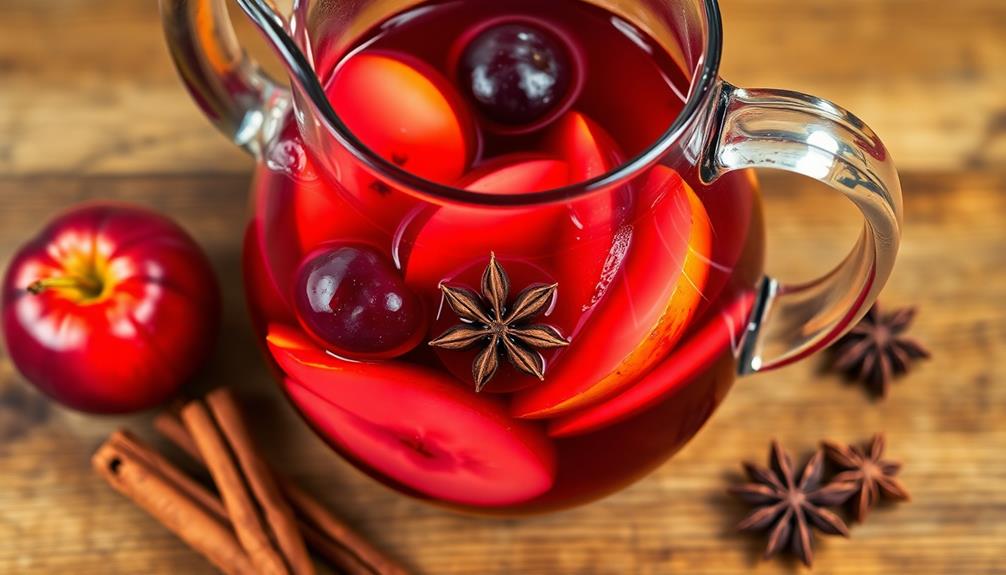You'll love żurek, a tangy Polish soup that's been warming hearts for centuries! This hearty dish starts with a sour rye starter, fermented for days to create its signature flavor. You'll simmer kielbasa, veggies, and eggs in this tangy base, creating a rich, comforting meal. Top it with a dollop of sour cream and fresh dill for the perfect finish. It's not just soup; it's a taste of Polish history and culture in every spoonful. Serve it with crusty rye bread for dipping, and you've got a meal that'll transport you straight to the Polish countryside. There's so much more to discover about this delicious tradition!
Key Takeaways
- Sour Rye Soup (żurek) is a traditional Polish dish with a tangy flavor, made from fermented rye flour.
- Key ingredients include rye flour, kielbasa, potatoes, carrots, eggs, and sour cream.
- The soup's distinctive taste comes from fermenting rye flour for 3-5 days before cooking.
- It's typically served with hard-boiled eggs and dill, accompanied by crusty rye bread.
- Żurek holds cultural significance in Poland, representing centuries of culinary tradition and heritage.
History
Sour rye soup's origins can be traced back to medieval Poland, where it emerged as a staple dish among peasants and farmers. You'll find that this hearty soup has been warming Polish bellies for centuries, evolving from a simple peasant meal to a beloved national dish.
Historically, Polish families would gather around the table to enjoy this comforting dish, often made with safety and durability in mind, using ingredients that were both accessible and wholesome.
As you explore the history of żurek, you'll discover that it was born out of necessity. Resourceful Polish cooks used readily available ingredients like rye flour, water, and leftover bread to create a filling and nourishing meal. They'd ferment the mixture for several days, resulting in a tangy, sour flavor that's become the soup's signature taste.
Over time, żurek's popularity spread beyond the countryside. You'd see it gracing tables in cities and towns, becoming a cherished part of Polish culinary tradition.
Today, it's not just a simple soup but a symbol of Polish culture and heritage. You'll find variations of żurek across Poland, each region adding its own unique twist to this centuries-old recipe. It's amazing how a humble soup has stood the test of time!
Recipe
Sour rye soup, also known as żurek or white borscht, is a traditional Polish dish with a distinctive tangy flavor. This hearty soup is made from fermented rye flour, creating a unique sour base that's both comforting and refreshing.
The key to a delicious sour rye soup lies in the preparation of the fermented rye starter, called zakwas. This process involves fermenting rye flour and water for several days to develop the characteristic sour taste. Once the starter is ready, it's combined with a flavorful broth, smoked meats, and vegetables to create a rich and satisfying soup.
- 1 cup rye flour
- 4 cups water (for zakwas)
- 6 cups chicken or vegetable broth
- 1/2 pound smoked kielbasa, sliced
- 2 large potatoes, diced
- 2 carrots, diced
- 1 onion, chopped
- 2 cloves garlic, minced
- 2 bay leaves
- 1 tablespoon dried marjoram
- 2 hard-boiled eggs, halved
- 1/4 cup sour cream
- Salt and pepper to taste
To prepare the soup, start by making the zakwas: mix rye flour with water in a jar and let it ferment for 3-5 days at room temperature. Once ready, strain the liquid and set aside.
In a large pot, sauté the onions and garlic, then add the broth, kielbasa, potatoes, carrots, bay leaves, and marjoram. Simmer until vegetables are tender. Add the strained zakwas to the pot and cook for an additional 10 minutes. Season with salt and pepper, then serve hot with halved hard-boiled eggs and a dollop of sour cream.
For the best results, use high-quality smoked kielbasa and allow the zakwas to ferment for at least 4 days to develop a strong, sour flavor. If you don't have time to make the zakwas from scratch, some specialty stores sell ready-made versions.
Be careful when adding the fermented rye liquid to the soup, as it can curdle if added to boiling broth. Instead, temper it by slowly whisking in some of the hot broth before adding it to the pot.
Cooking Steps
You're about to embark on a delicious culinary journey with sour rye soup!
First, you'll need to soak those dried mushrooms overnight, then simmer a rye flour mixture to create the soup's base.
As you add kielbasa and veggies, don't forget to temper the eggs carefully before stirring them in, and finally, season with fresh dill for that perfect finishing touch.
Step 1. Soak Dried Mushrooms Overnight

The night before you plan to make sour rye soup, place your dried mushrooms in a bowl of cold water. This simple step is crucial for bringing out the best flavors in your soup. As the mushrooms soak, they'll slowly absorb the water, becoming plump and tender. You'll be amazed at how they transform overnight!
Make sure you've got enough water to cover the mushrooms completely. They'll expand as they soak, so add a bit extra to be safe. In the morning, you'll find that the water has turned a rich, dark color. Don't throw this away! It's full of earthy mushroom flavor that'll make your soup even more delicious.
When you're ready to cook, gently squeeze the mushrooms to remove excess water. Slice them thinly, and they'll be perfect for your soup.
Step 2. Simmer Rye Flour Mixture

With your mushrooms ready, it's time to focus on the heart of sour rye soup: the rye flour mixture. In a large pot, combine rye flour with lukewarm water, stirring vigorously to create a smooth paste.
Add a slice of rye bread and a dollop of sour cream, then cover the pot with a clean kitchen towel. Let this mixture sit in a warm spot for 3-5 days, stirring occasionally. You'll notice it start to ferment and develop a tangy aroma.
Once your rye mixture has fermented, it's time to simmer. Pour it into a large pot and add water, stirring constantly to prevent lumps.
Bring the mixture to a gentle boil, then reduce the heat and let it simmer for about 20 minutes. The soup will thicken and become velvety smooth. After the 20 minutes, remove the soup from heat and let it cool slightly. Once it’s cooled a bit, use an immersion blender to puree the mixture until it’s completely smooth. This refreshing summer soup is perfect for hot days and can be served hot or cold, making it a versatile dish for any occasion.
As it simmers, you'll smell the rich, earthy aroma of rye filling your kitchen. Keep stirring occasionally to ensure even cooking and prevent sticking. This simmering process is crucial for developing the soup's signature tangy flavor and creamy texture.
Step 3. Add Kielbasa and Vegetables

Now that your rye base is simmering, it's time to add the hearty ingredients that'll give your soup depth and texture.
Grab your kielbasa and slice it into bite-sized pieces. You'll want about a pound of this savory sausage to really pack a flavor punch. Toss the kielbasa into the pot and watch as it infuses the broth with its smoky goodness.
Next, it's veggie time! Dice up a large onion and a couple of carrots. These will add sweetness and color to your żurek.
Don't forget the potatoes – cube two medium-sized ones for that perfect, comforting starch. Add all these veggies to the pot and give it a good stir.
Let everything simmer together for about 20 minutes. You'll know it's ready when the potatoes are tender and the kielbasa is plump and juicy.
The aroma filling your kitchen will be irresistible! Your żurek is coming together beautifully, and you're just a few steps away from a bowl of Polish comfort food heaven.
Step 4. Temper Eggs Into Soup

Eggs are the secret to achieving that creamy, luxurious texture in your żurek. To temper them, you'll need to be careful not to scramble them in the hot soup.
First, crack two or three eggs into a medium bowl and whisk them until they're well combined. Now, here's the tricky part: slowly add a ladle of hot soup to the eggs while whisking constantly. This will gradually warm up the eggs without cooking them.
Once you've added about a cup of soup to the eggs, it's time to pour the mixture back into the pot. Stir continuously as you add the egg mixture to prevent any clumping.
You'll notice the soup start to thicken and become slightly cloudy. That's perfect! Keep stirring for another minute or two to make sure the eggs are fully incorporated.
The heat from the soup will cook the eggs, creating a silky smooth texture that's absolutely delicious. Your żurek is now ready to serve, with a rich, velvety consistency that'll warm you from the inside out.
Step 5. Season With Dill and Serve

The finishing touches elevate your żurek from good to extraordinary. Now it's time to add the final seasonings that'll make your soup sing with flavor.
Grab a handful of fresh dill and chop it finely. Sprinkle most of it into the soup, stirring gently to distribute it evenly. The dill's bright, tangy aroma will complement the soup's sourness perfectly.
Adding a squeeze of lemon juice can enhance the soup's taste, much like how celery juice is known for its detoxification properties.
Taste your żurek and adjust the seasoning. You might need a pinch more salt or a dash of black pepper to balance the flavors. If you like, add a squeeze of lemon juice for extra zing.
Once you're happy with the taste, ladle the steaming soup into warm bowls.
For a traditional touch, serve your żurek with halved hard-boiled eggs floating on top. Garnish each bowl with a sprinkle of the remaining dill and a dollop of sour cream if you'd like. The creamy white swirls will create a beautiful contrast against the rich, dark soup.
Serve immediately with crusty rye bread on the side for dipping. Your homemade żurek is now ready to warm hearts and bellies!
Final Thoughts
Versatility makes sour rye soup a standout dish in Polish cuisine.
You'll find that this hearty meal can be enjoyed year-round, warming you up on chilly days or refreshing you during summer. It's a dish that connects you to centuries of Polish tradition, bringing a taste of history right to your table.
As you've seen, making żurek isn't complicated, but it does require some patience.
The fermentation process is key to developing that distinctive tangy flavor you'll come to love. Don't be afraid to experiment with toppings and add-ins – that's part of the fun! You might prefer it with more vegetables or extra meat, making it truly your own.
Frequently Asked Questions
Can żUrek Be Made Vegetarian or Vegan?
You can definitely make a vegetarian or vegan version of this soup!
To do this, you'll need to swap out the meat-based ingredients for plant-based alternatives.
Try using vegetable broth instead of meat stock, and add mushrooms or tofu for texture.
You can also use plant-based cream or coconut milk to achieve a creamy consistency.
Don't forget to keep the key flavors like rye flour and fermented ingredients to maintain that tangy taste you're looking for!
How Long Does żUrek Stay Fresh in the Refrigerator?
When you've made a delicious batch of soup, you'll want it to last! You can keep your homemade soup fresh in the refrigerator for about 3-4 days.
Make sure to store it in an airtight container to keep it at its best. If you want it to last longer, you can freeze it for up to 3 months.
Just remember to cool it completely before refrigerating or freezing. When you're ready to eat, reheat it thoroughly and enjoy!
What Are Common Side Dishes Served With żUrek?
When you're enjoying a hearty bowl of this delicious soup, you'll want some tasty sides to complete your meal.
Popular choices include boiled or roasted potatoes, which soak up the flavorful broth. You might also find crusty bread or rolls perfect for dipping.
Hard-boiled eggs are a common addition, often sliced and floating in the soup itself.
For a fresh contrast, try a crisp green salad or pickled vegetables on the side.
These accompaniments enhance your dining experience!
Is żUrek Typically Eaten for Breakfast, Lunch, or Dinner?
You'll find this hearty soup enjoyed at various mealtimes!
It's often served for breakfast, giving you a warm, energizing start to your day. Many people also love it for lunch, as it's filling and satisfying.
Don't be surprised to see it on dinner tables too! Its versatility means you can savor this delicious dish whenever you're in the mood.
Whether it's morning, noon, or night, there's always a good time to enjoy this tasty soup!
Are There Regional Variations of żUrek Throughout Poland?
You'll find that żurek varies across Poland, with each region adding its own twist!
In some areas, you might taste white sausage, while others use smoked meat. The soup's thickness can change too. Some regions add cream, others don't. Toppings like hard-boiled eggs or potatoes differ as well.
Even the sourness level can vary! It's exciting to explore these regional differences, as they reflect local traditions and available ingredients.
You're in for a tasty adventure!









